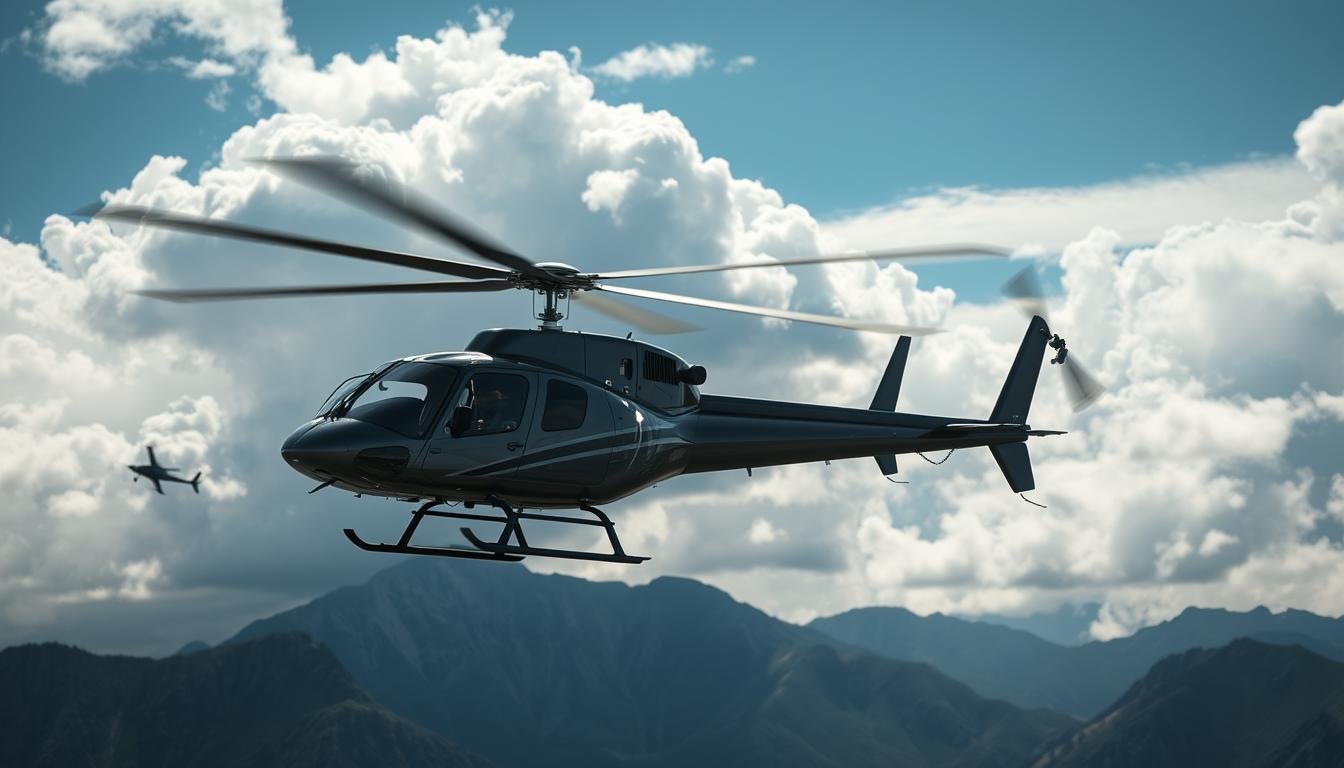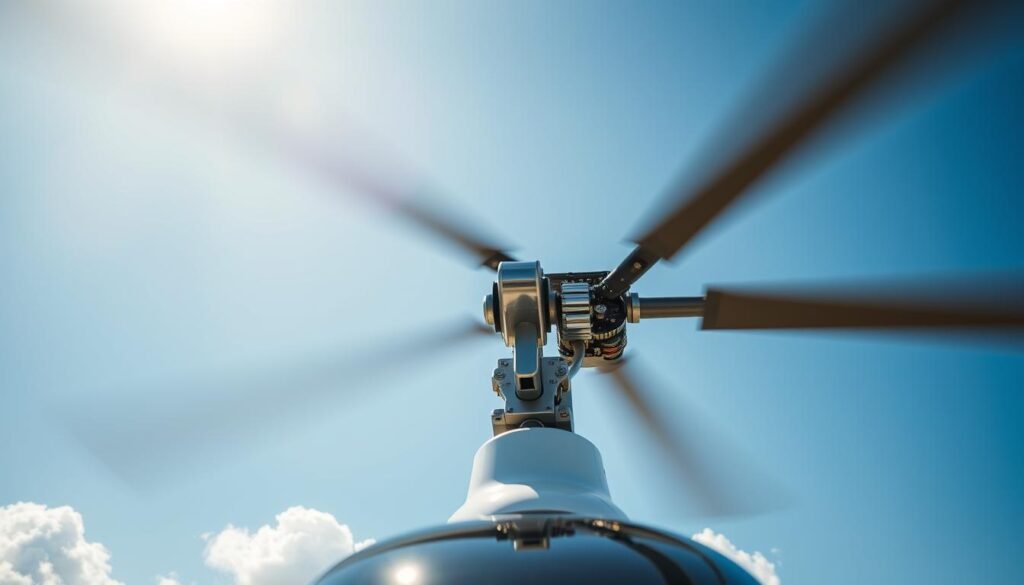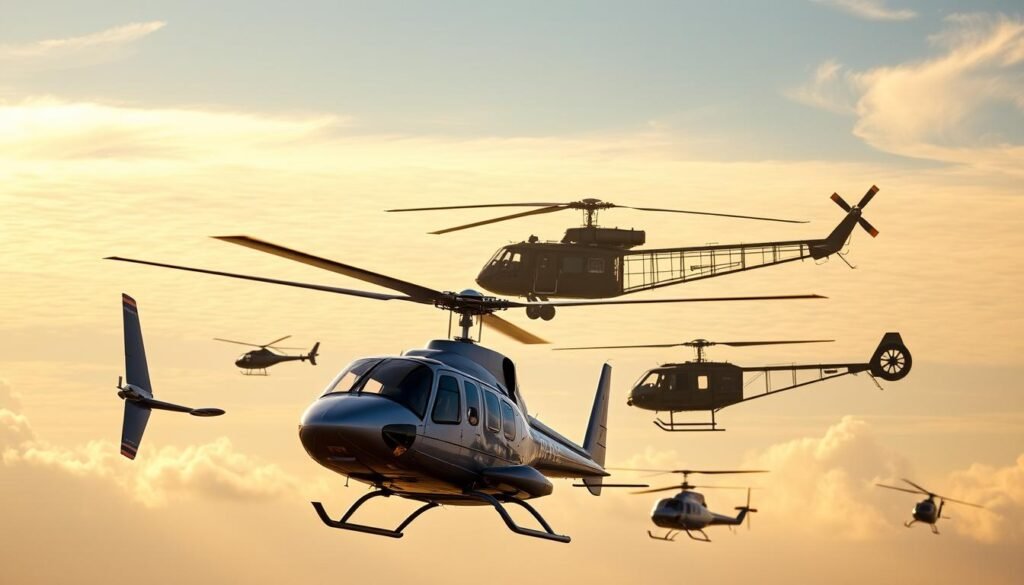Helicopter stunts start with precise planning, stringent FAA coordination, and a pilot who knows limits well.
Can a single aircraft and one skilled pilot truly make aerobatics both thrilling and safe?
Chuck Aaron set a modern benchmark by modifying a BO 105 and, in 2006, debuting the first FAA-approved aerobatic demo in the U.S. He brought 21,000 flight hours, work with NASA programs, and cinematic experience from Spectre to public airshows and lectures.
The BO 105’s design gave unique control authority that enabled approved maneuvers under documented risk controls. Future demonstrations will demand even tighter maintenance, training, and sponsorship alignment to protect crews and spectators.
Readers will see how real examples shape rules, why rotor dynamics and power margins matter, and what a credible skill ladder looks like before any public performance. Learn more background and case studies at this detailed guide.

Key Takeaways
- Precision and approval: Aerobatic displays require FAA coordination and documented risk controls.
- Proven pilots matter: Extensive hours across types underpin credibility for public demos.
- Aircraft choice is critical: Models like the BO 105 offer unique aerobatic capability.
- Training and maintenance: Future shows will push higher standards in simulation and checks.
- Ethics and safety: Protecting spectators and crew outweighs spectacle.
Helicopter Stunts Fundamentals For Future Flights
Foundational aerodynamic concepts decide whether an aerobatic profile is feasible in a given airframe. This section explains core physics, control coordination, and safe entry parameters for advanced maneuvers.
Core Aerobatics Concepts: Roll, Loop, And Low-G Management
The guide outlines rotor disc loading, power available, and energy management as determinants of a safe profile. It clarifies low‑G hazards like mast bumping and why strict pitch discipline prevents structural risk.
“Energy management and clear abort points save aircraft and lives.”
Helicopter Control Systems And Terminology For Stunt Pilots
Pilots must coordinate collective, cyclic, and anti‑torque inputs while watching rpm, torque, and engine response. Key terms include retreating blade stall, vortex ring state, translational lift, and power settling.
| Topic | Critical Parameter | Safe Margin |
|---|---|---|
| Roll/Loop Entry | Airspeed, Altitude, RPM | 20% above minimum power, +500 ft |
| Low‑G Risk | Pitch Attitude, Rotor Load | Avoid unloaded aft cyclic; maintain positive G |
| System Response | Governor Lag, Torque Transients | Pre‑set throttle; monitor droop |
Pre‑maneuver checklist: clearing turns, power set, RPM stable, abort criteria briefed. New pilots should build skill with energy‑conserving pitch changes, steep turns, then brief unloaded segments under instructor supervision.
For guidance on type transition and control adaptation, see the transitioning pilots guide.
Famous Helicopter Aerobatics: Chuck Aaron, BO 105, And Airshow Highlights
Chuck Aaron’s career reframed public expectations by pairing deep type experience with formal FAA approvals for aerobatic displays.
He built credibility through steady training, engineering partners, and strict operational limits.
Chuck Aaron’s Pioneering Career And FAA-Approved Demonstrations In The United States
Since 1972, Aaron logged roughly 21,000 hours across many types. That background underpinned disciplined decision-making and clear risk assessment.
In 2006, after extensive BO.105 modifications and coordination with Red Bull and the FAA, he flew the first U.S. FAA‑approved aerobatic demo. His process established a regulatory and engineering pathway others now follow.
“Energy management and clear abort points save aircraft and lives.”
Why The BO 105’s Aerobatic Characteristics Stand Out
The BO 105’s rigid rotor and responsive control feel give repeatable handling when maintained to strict standards.
Structural design, maintenance discipline, and pilot technique combine to allow advanced maneuvers while keeping margins predictable.

Spectre, California International Airshow, And The Udvar-Hazy Center Lectures
Aaron translated airshow routines to film as the stunt pilot for Spectre and showcased public demonstrations at events like the California International Airshow.
He also presented at the Steven F. Udvar‑Hazy Center in Chantilly, Virginia. That program was streamed live with closed captioning and supported by GE Aviation.
| Item | Relevance | Actionable Takeaway |
|---|---|---|
| FAA Approval (2006) | Regulatory milestone | Follow documented engineering and safety plans |
| BO 105 Design | High control authority | Match maintenance to performance envelope |
| Public Outreach | Education and transparency | Use lectures and streams to build safety literacy |
For contemporary context and a local profile of his airshow work, see this feature on a local air‑show.
Training, Aircraft Modifications, And Safety Systems For Helicopter Stunt Pilots
Progressive preparation and documented risk control form the path from basic competency to approved displays.
Staged Training Pathway: Start with instrument work and emergency procedures. Next, add advanced energy management and handling of low‑G scenarios. Finally, introduce limited aerobatic elements under instructor supervision, ideally in a dual‑control aircraft for initial checks.
Documenting The Safety Case For The FAA: A submission must include aircraft configuration, weight and balance data, rotor and drivetrain limits, maintenance history, pilot qualifications, and detailed stunt profiles with explicit abort criteria.

Working With The FAA, Sponsors, And Maintenance Teams For Aerobatic Approval
Scope modifications carefully: engine and governor tuning, rotor head inspections, restraint upgrades, and added instrumentation for data capture. Track component lives and record torque/temperature trends.
Safety System Architecture: Include redundant comms, telemetry for RPM/torque/EGT, on‑site ARFF coordination, and strict sterile‑zone enforcement with crowd setbacks that follow FAA and venue rules.
“Energy management and clear abort points save aircraft and lives.”
Operational Controls: Standardize crew briefs with roles for PIC, safety observer, maintenance lead, and event director. Use hard triggers for aborts, low‑altitude gating in early phases, and weather minima to avoid turbulence and density altitude risks.
- Pre‑flight checklist: configuration, instrumentation, and paperwork verified.
- Maintenance checks: pre/post event inspections and rapid discrepancy resolution.
- Administrative: insurance, waivers, and retained documentation for regulators and venues.
How To Plan And Execute Safe Helicopter Stunts In The Future
A disciplined planning workflow turns a high‑risk airshow profile into a repeatable, auditable operation.
Mission definition starts by naming objectives, choosing maneuvers, and setting safety criteria that mirror the BO 105 FAA approval model. Roles, resources, and regulatory steps map to a single executable flight plan.
Use a 30/14/7/1 pre‑event timeline for approvals, venue diagrams, crowd lines, ARFF coordination, and rehearsal slots. Validate emergency routes during each rehearsal.
Execution follows a strict script: engine start, systems checks, hover power validation, climb‑out gates, entry speeds/altitudes, callouts, and stabilized recoveries to a safe corridor.

| Phase | Key Action | Deliverable |
|---|---|---|
| Pre‑Event (30–1 days) | Notices, waivers, venue layout, rehearsals | Approved flight plan, crowd line map |
| Execution | Scripted checks, power gates, stabilized maneuvers | Telemetry and callout log |
| Post‑Flight | Telemetry debrief, exceedance review | Corrective actions and SOP updates |
Weather rules of thumb and human performance limits define go/no‑go criteria. An independent safety officer holds veto authority to protect the pilot and public.
“Energy management and clear abort points save aircraft and lives.”
Conclusion
A Disciplined Program, Not Improvisation, Defines How Advanced Aerial Displays Grow Safely In The United States.
Chuck Aaron’s 2006 FAA‑approved BO.105 aerobatic debut and his roughly 21,000 hours of experience show that strict training, engineering checks, and public education enable repeatable, safe demonstrations. His lectures and airshow work helped build a model that others can emulate.
Safe aerobatics come from vetted platforms, documented procedures, and crews who treat data and limits as mandatory. Teams should favor mentorship and institutional knowledge transfer so new pilots inherit validated practices instead of repeating avoidable errors.
Real incidents underscore the cost of lax oversight; see the Lake Tahoe dipping incident as a cautionary example. The final takeaway: apply checklists, training plans, and collaborative approval processes at every phase so future demonstrations raise the safety bar for helicopters and pilots alike.
FAQ
What are the essential aeronautical skills needed for advanced rotorcraft maneuvers?
Advanced rotorcraft maneuvers require precise stick-and-pedal coordination, energy management, and a solid understanding of autorotation and low-G recovery. Pilots must master cyclic and collective inputs to control attitude and descent rate, anticipate mast bumping conditions, and monitor rotor RPM closely. Regular practice in a certified aerobatic training program and simulator sessions strengthens decision-making under high workload.
Which aircraft types are proven for aerobatic helicopter displays?
Certain light, rigid-mast designs with redundant controls have proven suitable for aerobatic displays. The Messerschmitt-Bölkow-Blohm BO 105 is widely recognized for its rigid rotor and agility, which enabled certified aerobatics. Aircraft selection also depends on manufacturer approvals, structural limits, and modifications that meet FAA or EASA requirements.
How do pilots obtain authorization to perform aerobatic demonstrations in the United States?
Pilots coordinate with the Federal Aviation Administration for waivers and flight-protection measures. They submit a comprehensive operations plan, demonstrate pilot qualifications and aircraft airworthiness, and participate in safety briefings with event organizers. Sponsors and maintenance teams often assist by providing documentation and ensuring compliance with FAA Advisory Circulars.
What safety systems and modifications are commonly used for display flights?
Safety upgrades include reinforced airframes, telemetry, and emergency locator transmitters. Restraint systems, energy-absorbing seats, and enhanced maintenance inspections become mandatory for aerobatic certification. Any structural or control modification must follow manufacturer service bulletins and receive approval from the relevant aviation authority.
How is risk managed during low-altitude maneuvers and close formation work?
Risk management relies on conservative margins, clear briefings, pre-defined escape routes, and constant radio discipline. Pilots use standardized formation positions, strict altitude blocks, and continuous visual scanning. Event directors enforce minimum separation and require practiced recovery drills to reduce the chance of controlled flight into terrain or midair conflicts.
What training pathway leads to becoming an aerobatic rotorcraft pilot?
The pathway includes private and commercial rotorcraft certificates, followed by specialized aerobatic instruction from an experienced display pilot or approved school. Time-building, supervised aerobatic hours, and participation in airshows as a wing or safety pilot help build competence. Mentorship and documented proficiency checks are critical for progression.
Who are notable pioneers in rotorcraft aerobatics and where do they teach or display?
Chuck Aaron stands out as a pioneer, having flown certified aerobatic displays across North America and worked with museums, airshow organizers, and safety educators. He has lectured at venues including the Smithsonian’s Udvar-Hazy Center and performed at major airshows like those in California. Such pilots also collaborate with academies and industry partners to share best practices.
What role do sponsors and maintenance teams play in airshow approvals?
Sponsors fund logistics and often provide access to maintenance resources, while maintenance teams ensure the aircraft meets inspection intervals and any special airworthiness directives. Both help compile the technical packages required for regulatory approval, and they support contingency planning and spares during events.
How are aerobatic sequences planned to ensure structural limits are not exceeded?
Sequences are designed around published maneuver envelopes, load factor limits, and aircraft-specific restrictions. Pilots use written sequences, brief them thoroughly, and fly rehearsals in simulators or at higher altitudes. Engineers or experienced technicians often review planned maneuvers against service limits to prevent overstress.
What public venues and events commonly feature rotorcraft aerobatics and demonstrations?
Major airshows, aviation museums, and specialized fly-ins feature rotorcraft demonstrations. Examples include the California International Airshow, regional airshows, and museum events where pilots present educational talks. Organizers work with aviation authorities to set spectator safety zones and operational waivers.
How do pilots manage human factors like spatial disorientation during complex maneuvers?
Pilots maintain disciplined scan patterns, cross-check instruments, and rely on preplanned visual references. Crew resource management, physiological conditioning, and limiting exposure to prolonged unusual attitudes help reduce spatial disorientation. Regular training in simulators that reproduce low-G and unusual attitudes reinforces correct recovery techniques.
Are there published resources or courses covering rotorcraft aerobatics fundamentals and terminology?
Yes. Technical manuals, FAA advisory circulars, and specialized courses from accredited flight schools cover fundamental aerodynamics, control-system terminology, and low-G management. Pilots also reference manufacturer flight manuals and attend seminars by experienced display pilots to stay current with best practices. autonomous systems and hybrid propulsion, the future of helicopter stunts promises even greater possibilities. These developments will not only expand the range of achievable stunts but also improve safety and sustainability in the field. The enduring appeal of helicopter stunts lies in their ability to inspire and captivate, pushing the boundaries of what is possible in aviation.



